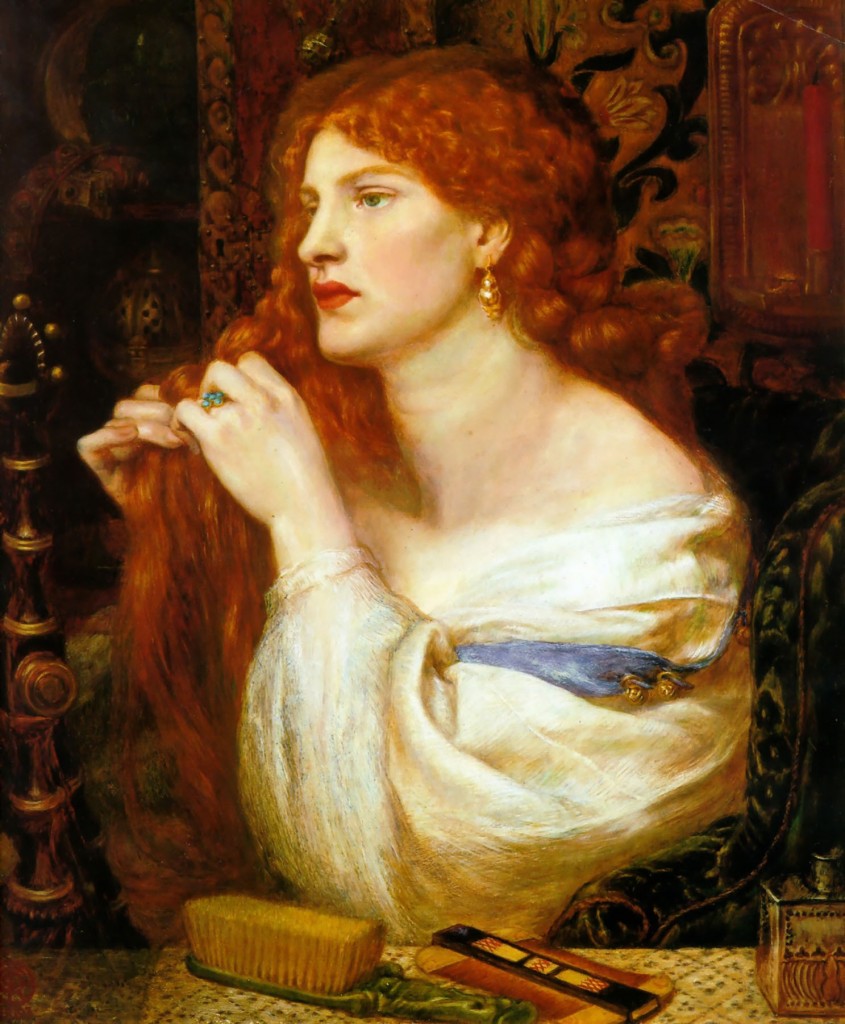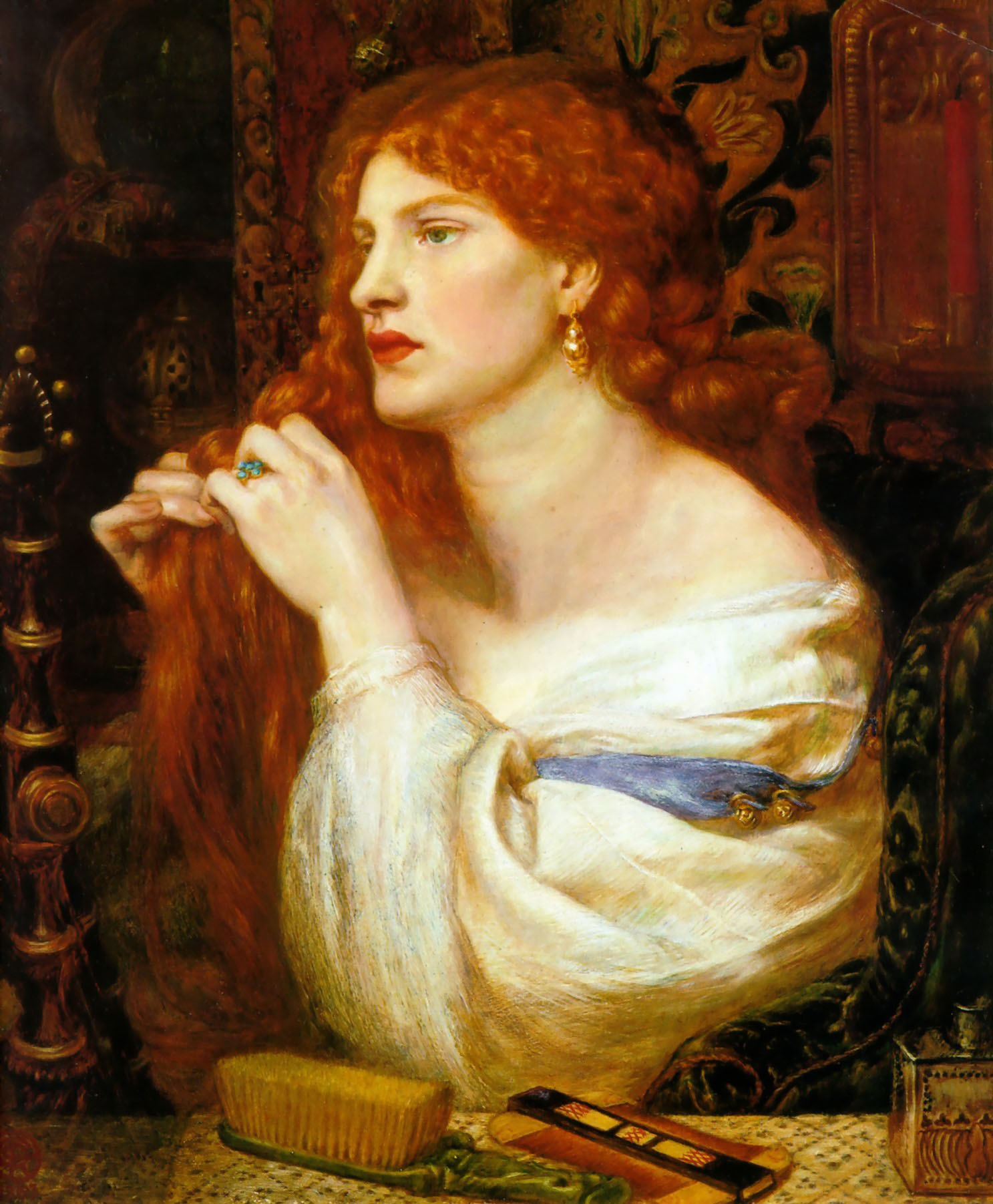Some call it a fashion revolution. Some call it a cult of beauty and Victorian counterculture. The Aesthetic Movement was, in essence, a dramatic change in fashion history, where artists of all types in mid Victorian England subtly rose against what they were witnessing; the dehumanization of the Industrial Age. All the rigid garments of Victorian styles of that time served as inspiration to start designing more comfortable clothing based on historic costume of medieval times. Corsets and the rigidity of the outfit as a whole was viewed as unattractive and even artificial.
Diving in deeper into the historical background of this movement, you will learn that London’s Great Exposition of 1851 (“featured aspects of the Industrial Revolution, highlighting steam power, industry, and mass production”). There were large groups of artists and writers that firmly believed that the “loss of cottage industry and individually crafted goods would not benefit society” and they had a strong perspective towards the Victorian society as “rigid and obsessed with a false respectability as foolish”. As a result, a less restricted ‘culture’ arose that relied on hand crafted goods and clothing based on the styles of late middle ages. Why the late middle ages? The Medieval garments had the best of everything; simplicity, elegancy and it was quite beautiful. You could say that individuals who were part of the aesthetic movement differed from the feminine ideal of that time. You can clearly see this throughout paintings. Take Rossetti, for example; his paintings exemplify the look of the aesthetic movement. The women in his paintings were tall and had very strong features with “long flowing red or brunette hair”, whereas the ideal women of that time were delicate, small and considered “proper” blondes. His sister, Christina Rossetti was a poet and considered to be an icon of the Aesthetic Movement. Instead of having such a formal image of Victorian England, the aesthetic movement depicted women in a leisurely pose with a soothing expression.
as foolish”. As a result, a less restricted ‘culture’ arose that relied on hand crafted goods and clothing based on the styles of late middle ages. Why the late middle ages? The Medieval garments had the best of everything; simplicity, elegancy and it was quite beautiful. You could say that individuals who were part of the aesthetic movement differed from the feminine ideal of that time. You can clearly see this throughout paintings. Take Rossetti, for example; his paintings exemplify the look of the aesthetic movement. The women in his paintings were tall and had very strong features with “long flowing red or brunette hair”, whereas the ideal women of that time were delicate, small and considered “proper” blondes. His sister, Christina Rossetti was a poet and considered to be an icon of the Aesthetic Movement. Instead of having such a formal image of Victorian England, the aesthetic movement depicted women in a leisurely pose with a soothing expression.
Leaning in more towards this movement applied specifically in fashion, the general idea was that “the wives, daughters and women in general who were involved in the movement wore the medieval inspired garments at home and in public”. The elements that were incorporated in the fashion during this movement was quite the contrast with the Victorian style. Aesthetic dress focused on “freedom” of the act of moving around, whereas the typical Victorian style was very stiff and constricted. Another great difference were the bodices; the Victorian woman would wear restrictive corsets to achieve the ‘fashionable’ hourglass figure, and women that were part of the aesthetic movement would only wear long, flowing dresses with very soft pleats and folds, and completely rejected the stiff corsets of the day. Interestingly, the aesthetic movement hated the new, manufactured dyes, so the dye they used were all natural made from vegetables. Again, a clear contrast is seen by the colors used. The aesthetic movement used muted colors, natural tones brown, russet red, terra cotta, cobalt, moss green and more.
Lastly, the Aesthetic Movement was often ridiculed by the media and society. Many disrespected the ‘messy’ image. Like one would imagine, the ideals of this movement soon became part of the usual, or the ‘mainstream’. Since then, the morals and aesthetics of this movement gained a large amount of popularity and was “no longer a revolutionary concept” but a source of inspiration for designers in the late 19th and early 20th centuries.
Reflection:
I loved writing this small research paper because it was about something I’ve never really thought about; manmade vs machine in the fashion industry, and how in the past, machine was considered ‘fake’. After doing some research about the Aesthetic Movement, I genuinely understand the perspective of the people that took part in it. I understand why they would believe all those things about machine-made items (specifically clothing), because of their context. The time period these individuals lived in was a time so different from ours today. In our world, our clothing is much more comfortable and developed in comparison to the Victorian period. That’s why when I started to read about how machine and mass production was a huge negative to them, I kept thinking how machines for our time period has led us to great achievement, and this can be applied to literally anything! Specifically to fashion, sewing machines of all sorts have made it so much easier for designers to achieve their designs and make it perfect, and still, handmade items are considered somewhat special because it takes a very specific set of skills to create a couture piece with immense detail and perfectionism.

Excellent…. great research and insight